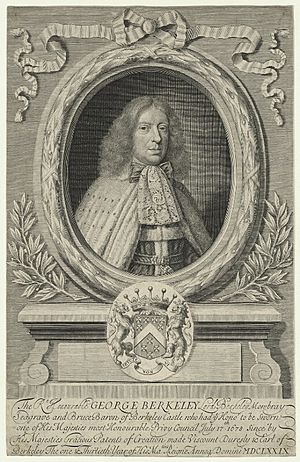George Berkeley, 1st Earl of Berkeley facts for kids
Quick facts for kids
The Earl of Berkeley
|
|
|---|---|
 |
|
| Personal details | |
| Born | c. 1628 England |
| Died | 10 October 1698 (aged 69–70) England |
| Resting place | Cranford, Middlesex |
| Spouse |
Elizabeth Massingberd
(m. 1646) |
| Children | 7, including Charles and Henrietta |
| Parents | George Berkeley, 8th Baron Berkeley Elizabeth Stanhope |
George Berkeley, 1st Earl of Berkeley (born around 1628 – died October 10, 1698), was an important English politician and nobleman. He was a member of the Privy Council, which advised the King, and a Fellow of the Royal Society, a group for top scientists. He served in the English Parliament and held several key roles during his lifetime.
Contents
Life of George Berkeley
George Berkeley was the son of George Berkeley, 8th Baron Berkeley, and Elizabeth Stanhope. He studied at Christ Church, Oxford, but did not complete a university degree.
Early Political Career
In 1654, George Berkeley was chosen to be a Member of Parliament for Gloucestershire. He served in the First Protectorate Parliament. He was re-elected for Gloucestershire in 1656 for the Second Protectorate Parliament.
In 1658, he inherited the title of Baron Berkeley. In May 1660, he was one of the special representatives sent to the Hague. Their important job was to invite King Charles II to return to England and take back his throne.
Public Service and Royal Connections
After the King returned, George Berkeley was given the role of keeper of the gardens and parks at Nonsuch Palace. This was a grand royal residence.
In 1661, he joined the council that dealt with foreign plantations. These were English settlements in other parts of the world. In 1663, he became a member of the Royal African Company. This company was involved in trade in Africa. In the same year, he was elected a Fellow of the Royal Society, recognizing his interest in learning and discovery.
He became a privy councillor in 1677. This meant he was a trusted advisor to the King. In April 1678, he joined the Board of Trade, which managed England's trade and colonies.
Becoming an Earl
On September 11, 1679, George Berkeley was given the new titles of Viscount Dursley and Earl of Berkeley. This was a great honor.
In 1680, he was elected to lead the Levant Company, a trading company that worked in the Middle East. He held this position for many years. In 1681, he became one of the masters of Trinity House, an organization that looks after lighthouses and navigation. He was also a member of the East India Company, which traded with Asia.
In 1685, he was appointed Custos Rotulorum of Gloucestershire, a senior judicial role. He was also sworn into the Privy Council again. After King James II left England in 1688, George Berkeley was among the noblemen who formed a temporary government.
In 1698, he was nominated to be an ambassador to Constantinople. However, he did not want to go and asked Parliament to excuse him. He passed away in England later that year. He was buried in the church at Cranford, Middlesex, where he owned an estate.
His Writings
In 1668, George Berkeley published a religious book. It was called Historical Applications and Occasional Meditations upon several Subjects.
Family Life
George Berkeley married Elizabeth Massingberd on August 11, 1646. Elizabeth was the daughter of John Massingberd, who worked for the East India Company.
Together, they had two sons and six daughters:
- Charles Berkeley, 2nd Earl of Berkeley (born 1649 – died 1710)
- George Berkeley (died 1694), who became a clergyman.
- Lady Elizabeth Berkeley (born around 1650 – died 1681)
- Lady Theophilia Berkeley (born 1650 – died 1707)
- Lady Arabella Berkeley
- Lady Mary Berkeley (died 1719)
- Lady Arethusa Berkeley (died 1743)

